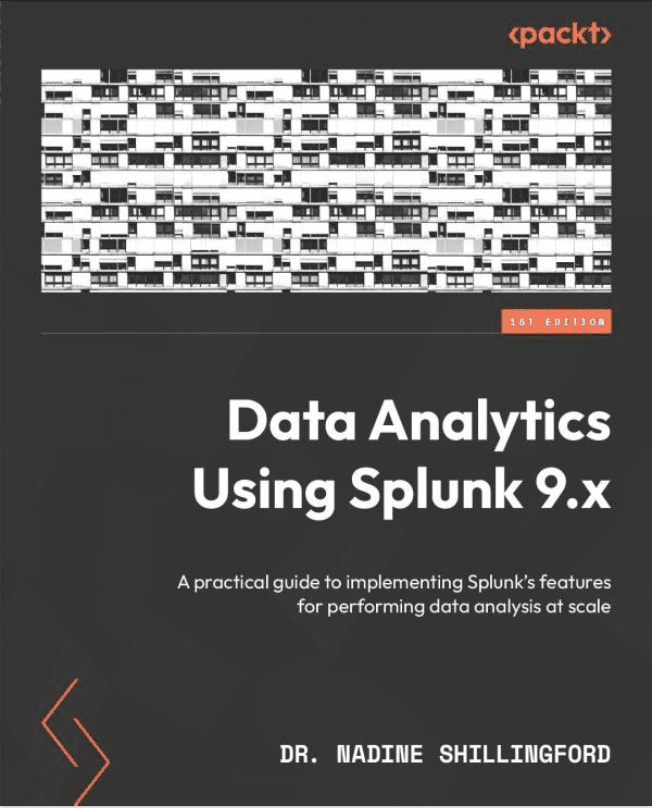Nadine Shillingford is the author of Data Analytics with Splunk 9.x, we got the chance to sit down and find out more about her experience of writing with Packt.
Q: What are your specialist tech areas?
Nadine: Splunk, data analytics, security
Q: How did you become an author for Packt? Tell us about your journey. What was your motivation for writing this book?
Nadine: I was approached by the Packt team based on my background in my LinkedIn profile. They proposed the idea of a Splunk book and I decided to write it based on my experience with Splunk. The topics in the book tries to cover as much of the need-to-know Splunk information that I have gathered over the years as a Splunk architect.
Q: What kind of research did you do, and how long did you spend researching before beginning the book?
Nadine: Since most of the material was based on experience, I basically relied on the Splunk docs to ensure that I had the correct syntax and commands for my examples. I also did some research on the newer technologies such as federated search and container management.
Q: Did you face any challenges during the writing process? How did you overcome them?
Nadine: During the writing process, I faced issues with deciding on a case study. I decided to go with the BOTS dataset since it is a real world compilation of logs. I wish I had more time and space to dig deeper into the dataset. Since I worked full time, I had to find time after hours to work on the book. This resulted in a few delays. Lastly, I struggled with what to include in the book. Splunk has so many interesting features, I had to be careful to not overload the book but also to keep the material interesting.
Q: What’s your take on the technologies discussed in the book? Where do you see these technologies heading in the future?
Nadine: Data analytics will become more and more relevant. Tools such as Splunk make it easy to gain insight into large quantities of data. I see the need to learn these tools as vital for anyone in the data field.
Q: Why should readers choose this book over others already on the market? How would you differentiate your book from its competition?
Nadine: This book introduces new technology in Splunk such as federated search and container management. It is a concise but thorough exploration of Splunk with multiple examples.
Q: What are the key takeaways you want readers to come away with from the book?
Nadine: Splunk is a powerful tool in the hands of a data analyst. Learning the basics of Splunk is a first step in getting certified. The book gives the reader an opportunity to explore Splunk with simple to understand instructions and examples.
Q: Can you share any blogs, websites and forums to help readers gain a holistic view of the tech they are learning?
Nadine: Splunk docs, Splunk answers
Q. What advice would you give to readers learning tech? Do you have any top tips?
Nadine: There are many aspects of tech. Find your niche and learn as much as you can.
Q. How would you describe your author’s journey with Packt? Would you recommend Packt to aspiring authors?
Nadine: The Packt team has been hands-on throughout the process. They have been accommodating to me with time schedules and changes to the content. Very courteous group. Yes I would recommend Packt.
Q: Do you belong to any tech community groups?
Nadine: Splunk Trust, Splunk Usergroups, ACM
Q: What are your favorite tech journals? How do you keep yourself up to date on tech?
Nadine: I get the ACM Technews and ACM Bulletin. I also keep in touch with Splunk via the Splunk Slack usergroup.
Q: How did you organize, plan, and prioritize your work and write the book?
Nadine: I created the outline based on the topics I thought were important for someone who is learning Splunk. I thought it was important to understand why Splunk is useful and what makes up Splunk. Then I guided the reader into understanding Splunk SPL and how it can be used to create dashboards and reports. The first few chapters were focused on topics that would help a Splunk user or power user. The latter part of the book goes into Splunk administration, keeping it interesting for more advanced readers. Throughout the book I wanted to ensure that I included examples where they were helpful.
Q. What is that one writing tip that you found most crucial and would like to share with aspiring authors?
Nadine: Plan well at the beginning so you don’t have to make too many changes once you get going.
Q. Would you like to share your social handles? If so, please share.
Nadine: Instagram and Facebook: charcoalattebynadine, LinkedIn: https://www.linkedin.com/in/nadineshillingford/, Splunk slack: theothernadine
You can find Nadine‘s book on Amazon by following this link: Please click here









